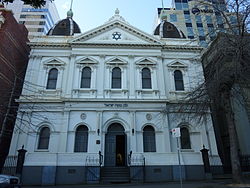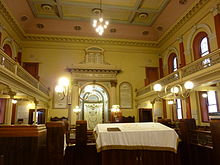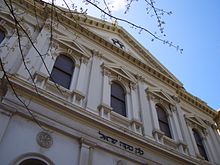- East Melbourne Hebrew Congregation
-
East Melbourne Hebrew Congregation Basic information Location 488 Albert St, East Melbourne, Victoria,  Australia
AustraliaGeographic coordinates 37°48′33″S 144°58′27″E / 37.80926°S 144.97415°ECoordinates: 37°48′33″S 144°58′27″E / 37.80926°S 144.97415°E Affiliation Orthodox Judaism Year consecrated 1877[1] Status Active Leadership Rabbi Dovid Gutnick Website melbournecitysynagogue.com Architectural description Architect(s) Crouch & Wilson[2] Architectural style Renaissance Revival Direction of façade South Groundbreaking 20th March, 1877 Completed 1877 Construction cost £7000 Specifications Capacity 470 Length 22.2m (73 ft) Width 12.8m (42 ft) Height (max) 9.4m (31 ft) Dome(s) 2 Materials Brick The East Melbourne Hebrew Congregation (Hebrew: ק"ק מקוה ישראל), also known as East Melbourne Shule, East Melbourne Synagogue, Melbourne City Synagogue or City of Melbourne Synagogue[3] is a historically significant Jewish congregation in East Melbourne, Victoria, Australia. The synagogue, consecrated in 1877, is the oldest in Melbourne.
Contents
History
The congregation was formed in 1857[4] under the leadership of Reverend Moses Rintel following his leave from the Melbourne Hebrew Congregation.[5] Initially named Mikveh Israel Melbourne Synagogue,[6] it was provided with a government land grant in 1859 on the corner of Little Lonsdale Street and Stephen Street (today Exhibition Street) in Melbourne's City Centre.[5][7] A small synagogue was erected on the site in 1860.[1] The congregation consisted primarily of Rintel's followers, including German[2] and Eastern-European[8] Jews who lived in Melbourne's inner-city suburbs within walking distance of the synagogue.
Seeking new premises, the congregation received government permission to sell its property in 1870. It moved to a new site on Albert Street, East Melbourne, where a new synagogue building was consecrated in 1877.[6] Rintel served the congregation until his death in 1880.[5]
In March 1977 the synagogue's centenary was celebrated with a special service led by Rabbi M. Honig.[9]
Architecture
Continuously in use since 1877, the East Melbourne Synagogue is the oldest in Melbourne[10] and the largest 19th-century synagogue in Victoria. It is listed on the Victorian Heritage Register[2] and is classified by the National Trust of Australia[11] due to its historical, social, and architectural significance.[2]
The two-storeyed synagogue was designed by noted Melbourne architects Crouch & Wilson. The internal space is surrounded on three sides by a gallery carried by cast iron columns, each surmounted by an unusual arrangement of an impost block flanked by consoles. The main ceiling is paneled, with a row of large and unusual ventilators marking the location of former suspended gas lights. The original interior, particularly the Bimah and Torah ark, remain in an intact state.
The building's facade, constructed in the style of Renaissance Revival, was completed in 1883. It comprises five bays. Tuscan pilasters divide the bays of the lower floor, and Corinthian pilasters divide the upper floor bays. Two dome-like mansard roofs flank the central pediment.[2][11]
Today
Led by Rabbi Dovid Gutnick since November 2007,[12] the congregation has a current membership of around 200 families.[13] It is currently the only synagogue in Melbourne's inner-city area.[7]
Regular Sabbath and holiday services have been held at the synagogue since its establishment, making it the oldest continuously active synagogue in Australia.
See also
- History of the Jews in Australia
- List of synagogues in Australia and New Zealand
- Oldest synagogues in the world
External links
- East Melbourne Hebrew Congregation website
- East Melbourne Synagogue on the Victorian Heritage Register
- East Melbourne Synagogue at the National Trust
Further reading
- History of the East Melbourne Hebrew Congregation "Mickva Yisrael", 1857–1977, By Morris C. Davis, East Melbourne Hebrew Congregation, 1977 ISBN 0-9596899-0-7, 978-0-9596899-0-7
- Historical Sketch of the Two Melbourne Synagogues Together with Sermons Preached, by Dattner Jacobson and Moses Rintel (1877), By Maurice Brodzky, Dattner Jacobson, Moses Rintel, Kessinger Publishing LLC, 2009 ISBN 1-104-17771-4
References
- ^ a b http://books.google.com/books?id=184NAAAAQAAJ&pg=PA47&lpg=PA47&dq=%22opened+for+divine+worship+in+1860%22&source=bl&ots=uo9j0UVg7W&sig=2dRag2nH5_WT2Hsu-fC6odnhWHY&hl=en&ei=kH--S9TXCMLflgegoL2ZBw&sa=X&oi=book_result&ct=result&resnum=1&ved=0CAYQ6AEwAA#v=onepage&q=%22opened%20for%20divine%20worship%20in%201860%22&f=false
- ^ a b c d e http://vhd.heritage.vic.gov.au/places/heritage/353
- ^ http://www.melbournecitysynagogue.com/index.html
- ^ http://jewishhistoryaustralia.net/jha/timeline.htm
- ^ a b c http://adbonline.anu.edu.au/biogs/A060040b.htm
- ^ a b http://books.google.com/books?id=lBVoAGKulA8C&pg=PA23&lpg=PA23&dq=East+melbourne+hebrew+congregation&source=bl&ots=PC715h1C51&sig=W3rk0Y_Sqos9g0--1MyYJL00f_4&hl=en&ei=3he-S5WjFcH6lwfwtomFBw&sa=X&oi=book_result&ct=result&resnum=8&ved=0CB8Q6AEwBzge#v=onepage&q=East%20melbourne%20hebrew%20congregation&f=false
- ^ a b http://www.onlymelbourne.com.au/melbourne_details.php?id=1879
- ^ http://books.google.com/books?id=wgoFxfSTfYAC&pg=PA528&dq=%22East+melbourne+hebrew+congregation%22&cd=7#v=onepage&q=%22East%20melbourne%20hebrew%20congregation%22&f=false
- ^ http://news.google.com/newspapers?id=eAgRAAAAIBAJ&sjid=jJIDAAAAIBAJ&pg=7105,6199576&dq=east-melbourne-synagogue&hl=en
- ^ http://books.google.com/books?id=lBVoAGKulA8C&pg=PA24&dq=%22East+melbourne+hebrew+congregation%22+%22oldest+synagogue%22&cd=1#v=onepage&q=%22East%20melbourne%20hebrew%20congregation%22%20%22oldest%20synagogue%22&f=false
- ^ a b http://www.nattrust.com.au/trust_register/search_the_register/mickva_yisrael_synagogue_east_melbourne_synagogue
- ^ http://www.zcv.org.au/site/images/downloads/szcannualreport2008.pdf
- ^ http://www.theage.com.au/national/sharing-a-new-shule-of-thought-20081225-7552.html?skin=text-only
Categories:- Synagogues in Melbourne
- 19th-century synagogues
- Religious buildings completed in 1877
Wikimedia Foundation. 2010.



